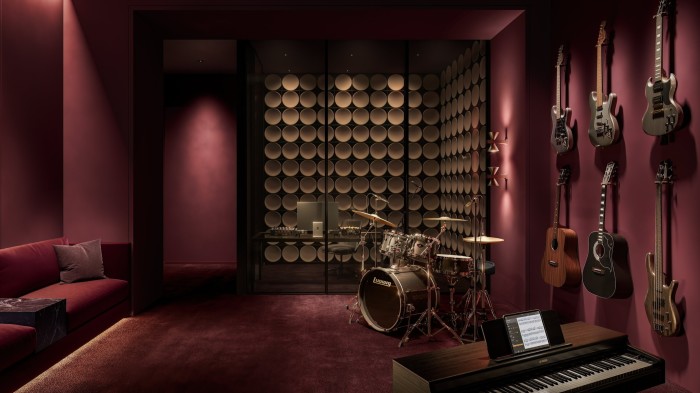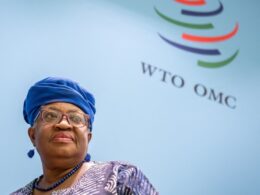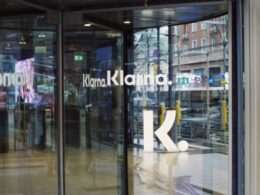In Nashville, Tennessee, it is not uncommon to have a recording studio at home — even if it’s not quite at the level of Taylor Swift, who reportedly transformed a 2,000 sq ft guesthouse on her six-acre home there into a spectacular space to lay down tracks. For artists with shallower pockets, apartments with professional recording studios are a staple in the city: take CODA, Margaux Midtown, The Lucile and Rye Charlotte Ave.
But it’s a trend that’s now stretching beyond “Music City”. Taking note of a new generation of buyers’ broadcasting and enterprising chutzpah, developers are starting to align themselves with content creators, artists, poets and musicians by including fully-fitted recording and podcasting studios as part of the building facilities.
“There has been a shift,” says Dan Hastings-Narayanin, deputy foresight editor at The Future Laboratory. “The creators who first boomed, predominantly on TikTok, were filming themselves on smartphones in their cars or bedrooms. Low production value was the norm — it was about authenticity and relatability. Now audiences expect better production: longer-form content on YouTube, podcasts available in high-resolution video and audio, and livestreams with proper lighting and set design. Creators looking to grow [are keen to] improve post-production.”
One developer with an eye on catering to this need is Certes Partners, with properties in New York, Washington DC, Nashville and Raleigh. It is behind The Reserve, an apartment and co-living space in Harlem, where it has installed a bijou home recording studio. “We first saw the concept at a property in Nashville and thought it would be intriguing to bring it to New York,” says Sunder Jambunathan, co-founder of Certes Partners.
The sound-insulated space is kitted out with a Shure MV7 microphone and a Berlingtone 20-Channel Professional Audio Mixer. It has proved multifunctional: as well as coming to record podcasts, residents also use it to listen to music, for Zoom calls and to practice an instrument. Jambunathan was unsure how well it would go down, but “we’ve been surprised how often it gets used,” he says. Apartments at The Reserve start from $3,640 a month for two bedrooms, or from $1,860 a month for a co-living arrangement in a four-bedroom, two-bathroom apartment.
Thirty-two-year-old Darius Ellis Ennin is a Ghanaian-American rapper, singer-songwriter and producer originally from Dallas, Texas, who has lived at The Reserve for just over a year and recently recorded his second album — titled Hustler. Like many of his generation, Ennin is a multi-hyphenate, and juggles various jobs to pursue his passion in the small hours. “I record every night, it’s crazy,” says Ennin, who performs under his stage name Ellis Blé. All his work is available to listen to on Spotify.
He moved to The Reserve specifically to balance his recording schedule. “I was previously living in New Jersey and every night I would get the train to Music Goals NYC, a boutique recording studio in Korea Town. It was draining,” he recalls. Now his studio is moments from his door.

This move by developers reflects a broader awareness of the need for more and better recording and content creation facilities; music rooms are also becoming a more common addition to the usual roster of amenities.
New York has, unsurprisingly, taken the idea and run with it. On Manhattan’s Upper West Side, overlooking the Hudson River, is Waterline Square, a condominium development with three residential towers; studio apartments of 639 sq ft are currently available from $5,360 a month. Residents have access to the Waterline Club which was designed by Rockwell Group and includes a jamming space with instruments and kit including drums, piano, guitars, mixing deck, a Trident sound mixer and music production software.
The Willow in Manhattan’s historic Gramercy also tapped Rockwell Group to design its interiors and amenities, which include the Glamercy Room, fitted out with instruments, vinyl collection and a recording studio. Again emphasising the multifunctional potential, it is designed for listening, playing and podcasting. The 19-storey block on 201 East 23rd Street has 69 apartments (one to four bedrooms), available from $1.335mn.


Over on the Upper East Side, rock star Lenny Kravitz designed the Sound Lounge for residents at The Kent to use for recording, rehearsals or performances. Inspired by his own studio, it includes a stage, dance floor, drum set, piano and audiovisual system to “jam with friends or throw a party where you can be both DJ and live performer”. Rock star style commands rock star prices, however: currently for sale at the 30-storey art deco condominium building is a five-bedroom, 3,564 sq ft apartment for $7.695mn. A similar size apartment is available for a monthly rent of $36,250.
Equally upscale is the Yabu Pushelberg-designed recording studio and music room at 255 East 77th Street, where a three-bedroom apartment is $5.3mn. And as a resident at limestone-clad The Harper, at 310 East 86th Street, you can also sign up for music lessons in the recording room from the School of Rock. A three-bedroom apartment is $3.55mn.
Miami is another city embracing main character energy. Developed by Related Group and Rockpoint, The Highley House in the vibrant Wynwood Arts District comprises 304 residences (a month’s rent starting at $2,454 for a studio), which have use of a “Creator Studio”, “for modern storytellers”.

UK developers are taking notes. On London’s South Bank, Native Land has an ear to the ground. At its just-opened flagship project Bankside Yards, Opus, the central residential building, is aimed squarely at millennials and Gen Z. Designed by studio PLP Architecture, with 249 apartments starting from £860,000, the amenities will include a podcast studio, co-working area and wellbeing facilities (including a padel court).
The building has been designed to resonate with “the experiential generation”, says Nicholas Gray, executive director of Native Land. Planning has focused around “nurturing creative pursuits and self-expression.” In addition to the podcasting space, there is also an art studio: “platforms that foster both personal and professional development,” says Gray.
Professional polish is key to progression. One of London’s best-known podcasters, rappers and artists is 34-year-old British artist George Mpanga, better known by his stage name George the Poet, who brings to light social issues on his critically acclaimed podcast Have You Heard George’s Podcast? He drafts much of his work at his home, in Harlesden, before he heads to the studio of his friend and producer, Benbrick.

“I spend about half the year researching, the other half recording,” he says of his process. “I make rough recordings at home, that’s how I started my podcast. Then my recordings are completed at Benbrick’s studio. Collaborating with someone who has a professional set-up helps me streamline the work. It’s a nice balance because being in a studio means we get the professional element, but it’s still a familiar, cosy environment for us,” he adds.
Back at The Reserve in East Harlem, Ennin is busy working on his next project, an EP. “This one is more Afrobeat influenced, to show my Ghanaian roots,” he explains. The best thing about being able to record at home? “I don’t even need to put on shoes to get to the studio.”
Find out about our latest stories first — follow House & Home on Instagram, and sign up to receive our House & Home Unlocked newsletter every Friday









